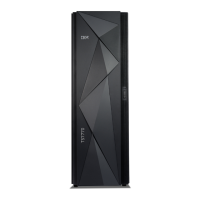August 15, 2017
© Copyright IBM Corporation, 2017 Page 8 of 117
Copy Export Operation Overview
Copy export provides a new function that allows a copy of selected logical volumes written to the TS7700
to be removed and taken offsite for disaster recovery purposes. The benefits of volume stacking, which
places many logical volumes on a physical volume, are retained with this function. In addition, since the
data being exported is a copy of the logical volume, the logical volume data remains accessible by the
production host systems.
The basic steps for using copy export are:
1. Determine the data that is needed for offsite disaster recovery purposes. Through the automatic class
selection routines, assign a management class that specifies a secondary volume pool to any data that is
to be copy exported. As logical volumes are written to the TS7700 and then closed, they will be
scheduled to be copied to a physical tape volume. With a management class that specifies a secondary
copy pool, the data is copied both to a primary pool physical volume and a secondary pool physical
volume. See the section on Setting up Data Management Definitions for Copy Export.
2. When it is time to remove the physical volumes that have a copy of the data on them, first write an
Export List File volume to the TS7700 that is to perform the copy export operation. The export list file
volume contains instructions for the copy export operation, one of the key instructions being the number
of the physical volume pool to export. The export list file volume will also hold a status file that
contains records generated by the TS7700 as part of the copy export operation. Second, once the export
list file volume has been written and closed, issue the Library Export z/OS console command. See the
sections on Creating the Export List File Volume and Copy Export Operation.
Note: It is expected that customers will execute the copy export operation on a periodic basis, possibly
even more than once a day. Since the purpose is to get a copy of the data offsite for disaster recovery
purposes, performing it soon after the data is created minimizes the time for the recovery point
objective.
3. In processing a copy export operation, the TS7700 first copies any logical volumes assigned to the pool
being exported that only have a copy of the logical volume in the cache. Next, each of the physical
volumes in the specified pool that contains active data is mounted and a database backup of the TS7700
is written to all or 4 of them. It can be selected by user at code level 8.21.x.x. See the sections on
Creating the Export List File Volume. Status records are written to the export list file volume and then
the physical volume is ejected from the library. Once all the physical volumes in the pool have been
processed, the copy export operation is complete. See the sections on Copy Export Progress Messages
and Export Status File Records.
On the completion of the copy export operation, a summary status console message is generated. The
status file on the export list file volume contains detailed information about the execution of the copy
export operation and should be retained for future reference. See the section on Host Completion
Message.
4. An operator removes the physical volumes from the I/O station of the library and prepares them for
shipment to an offsite location. See the section on Removing Copy Exported Volumes from the Library.
If a copy export operation must be stopped, it can be canceled either through a host command or through the
TS7700 on systems running 8.5.x.x code or higher or on the library manager for systems on pre 8.5.x.x
code. See the section on Canceling a Copy Export Operation.
To use the copy exported physical volumes for recovery, the following are the basic steps to perform:

